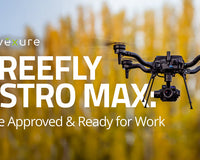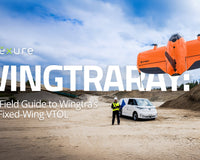Part 108 is the long-awaited FAA rule that promises to unlock Beyond Visual Line of Sight (BVLOS) drone operations at scale. Commercial and enterprise operators – from public safety teams using drones as first responders to industrial inspectors of pipelines and solar farms – have been eagerly watching its progress. But with repeated delays and silence from regulators, many are asking: Is Part 108 still happening?
This blog post will break down what Part 108 is, why it matters, what the ongoing delay signals, and what drone operators should do now to be ready.
What Is Part 108?
New BVLOS Drone Rule
Part 108 is the FAA’s upcoming regulation aimed at standardizing BVLOS operations for commercial drones . In essence, it would allow drones to fly beyond the visual line of sight of the operator under specified conditions – something not generally permitted under current rules.
Why it’s Needed
Under Part 107 (the current small UAS rule) drone pilots must keep aircraft within visual line of sight unless they obtain a special waiver . This VLOS restriction severely limits range and is a major hurdle for scaling operations. Part 108 represents a significant shift: it establishes a new framework so operators can perform long-range, complex missions without always needing an FAA waiver.
Genesis in Industry Demand
Recognizing the need for BVLOS, the FAA convened a BVLOS Aviation Rulemaking Committee (ARC) in June 2021 to recommend how Part 108 should work . The ARC included stakeholders from companies like Amazon Prime Air, Wing, law enforcement, and other experts. In March 2022, the ARC delivered a 381-page report with 70 recommendations, including the creation of a new Part 108 to enable safe BVLOS flight . This set the stage for the FAA to draft an official rule.
Anticipated Scope
Part 108 is expected to cover everything needed for safe BVLOS drone integration: from new tech requirements (like detect-and-avoid systems) to updated pilot training, certification standards, and operating rules. Essentially, it’s the rule that will take U.S. drone operations “to the next level” by allowing drones to routinely fly far beyond the operator’s eyesight, opening use cases that are impractical today.
Why Part 108 Matters for Commercial Operators
Unlocking Critical Use Cases
BVLOS capability is a game-changer across industries. For example, companies could inspect miles of power lines or pipelines in one drone mission instead of many short flights . Drone delivery providers could cover longer distances beyond neighborhoods. Agriculture could monitor large fields more efficiently, and public safety agencies could send drones ahead to emergency scenes without a pilot on-site . All of this becomes much more feasible under Part 108’s wider operating limits.
Economic and ROI benefits
Being able to fly BVLOS can dramatically improve the return on investment (ROI) for drone programs . Instead of dispatching personnel to chase drones or reposition for every short flight, companies can centralize operations and cover more ground with fewer launches. This means lower costs per inspection or response, and the ability to take on projects that are currently cost-prohibitive under VLOS constraints.
Keeping up with Global Competition
The U.S. drone industry doesn’t want to fall behind.
“While the US stalls on a rule, other countries are moving ahead. The government needs to be faster… we are falling farther and farther behind,” 'warns Edwin Sanchez, CEO of VOTIX.
Part 108 is seen as essential for U.S. companies to remain competitive internationally in drone tech, as nations like Canada, Australia, and EU members advance their own BVLOS regulations.
Safety and Innovation
A clear BVLOS rule can actually enhance safety by establishing standard requirements (e.g. equipage, pilot training) rather than the current patchwork of waivers. It also gives manufacturers and solution providers a target for innovation – for instance, developing reliable communication links and detect-and-avoid (DAA) systems that meet FAA’s performance standards . Many of these technologies are already proven and in testing today , so Part 108 could accelerate their adoption.
Public Safety Impact
Programs like Drone as First Responder (DFR) in law enforcement, which send drones to 911 calls ahead of officers, are currently limited by line-of-sight rules. With Part 108, a police department could remotely deploy a drone city-wide from a central hub, greatly reducing response times in emergencies. Firefighting, search-and-rescue, and border security missions could similarly benefit from BVLOS flexibility to cover large or inaccessible areas quickly.
“Overall, [the BVLOS rulemaking] was a herculean effort by the group – and assuming FAA moves forward with Part 108, it will lead to much greater integration of drones into the airspace.” – Mary-Caitlin Ray, former FAA attorney, on the ARC’s recommendations
Part 108 Timeline: Progress and Delays
2021 – ARC Launched:
In June 2021, the FAA established the BVLOS ARC to begin crafting recommendations for Part 108 . Hopes were high that a rulemaking would quickly follow. In late 2021, then-FAA Administrator Steve Dickson even stated an NPRM (Notice of Proposed Rulemaking) for BVLOS would be out by the end of 2022 .
March 2022 – ARC Report:
The ARC delivered its final report on March 10, 2022, urging the FAA to create Part 108 and detailing how it could work . This comprehensive plan included risk-based categories, pilot qualifications, technology mandates, and even sample rule language. Industry stakeholders saw this as a blueprint, and many expected the FAA to act swiftly on it.
Missed 2022 Deadline:
Despite the ARC’s work, no BVLOS NPRM came in 2022. The FAA’s promised timeline slipped. By mid-2023, officials were acknowledging delays. The drone industry’s patience began wearing thin as the “year of BVLOS” came and went with still no rule in sight .
FAA Reauthorization 2024 – A Push from Congress:
In an effort to force progress, U.S. lawmakers included a provision in the FAA Reauthorization Act of 2024 (signed May 16, 2024) directing the FAA to formally propose the BVLOS rule within 4 months . This set a September 16, 2024 deadline for the Part 108 NPRM. It was an aggressive timeline, reflecting the urgency Congress felt to move things forward.
September 2024 – Deadline Passes:
September 16 came and went with no NPRM published . At the Commercial UAV Expo that month, FAA representatives admitted they would miss the date and were now aiming for the end of 2024 or early 2025 for the NPRM . The only silver lining: FAA leaders reiterated that BVLOS is a priority and that work was ongoing behind the scenes.
Early 2025 – Still Waiting:
As of Q1 2025, the BVLOS NPRM has still not been released. Industry watchers are growing concerned that the delay signals internal challenges at the FAA – possibly resource constraints or shifting priorities after a change in the White House.
Some worry that if a draft rule doesn’t appear by mid-2025, the final rule could be pushed all the way to 2027, given the time needed for public comments and revisions . Such a scenario would greatly dampen innovation and investment, putting the U.S. drone industry at a disadvantage.
Why the delay?
Beyond bureaucratic hurdles, the FAA must balance safety and security concerns in writing Part 108 . Issues like airspace integration with manned aircraft, privacy, and national security are complex. It’s likely the rule is undergoing heavy inter-agency review (with the DOJ, DHS, DOD, etc.), which slows things down . Additionally, a new presidential administration in 2025 has brought different priorities; regulators are being cautious to ensure any new rule aligns with broader aviation safety goals.
Part 107 vs. Part 108 – What’s the Difference?
To understand the significance of Part 108, it helps to compare it with the existing Part 107 rules that most U.S. drone operations currently follow. Part 107 (enacted in 2016) covers small unmanned aircraft operations, but it has strict limitations – notably the requirement to fly within visual line of sight and away from most populated areas without waiver. Part 108 is expected to relax some of these restrictions under strict new conditions. Below is a summary of key differences between Part 107 and the projected Part 108 framework:
Operational Distance
Part 107 confines flights to the pilot’s visual line of sight (VLOS) unless a waiver is granted. Part 108 will explicitly permit beyond visual line of sight (BVLOS) operations as a standard practice (with required safety equipage) . This means far greater range for drone missions under Part 108.
Pilot Qualifications
Part 107 requires a Remote Pilot Certificate (obtained by passing a knowledge test), but no additional BVLOS-specific training. Part 108 will likely introduce a special BVLOS rating or certification for pilots. Operators may need to demonstrate extra knowledge in areas like risk management, airspace integration, and emergency procedures for BVLOS. (The ARC even suggested updating testing requirements for a “BVLOS rating” on top of Part 107.)
Drone Equipment
Part 107 imposes no requirement for onboard detect-and-avoid technology; drones just need to be <55 lbs and meet basic safety conditions. Part 108 is expected to mandate technology like Detect-and-Avoid (DAA) systems and robust communication links on drones. Equipment might need to be certified or comply with new standards to ensure reliability beyond line of sight. In short, Part 107 assumed a person could always see the drone; Part 108 will rely on the drone’s tech to maintain safety.
Operational Approvals
Under Part 107, if you want to fly BVLOS (or at night, over people, etc.), you must seek an FAA waiver or exemption each time, which is time-consuming and case-by-case. Part 108 will allow routine BVLOS flights without individual waivers as long as operators adhere to the rule’s built-in provisions . This shift from ad-hoc approvals to a blanket regulation is huge – it moves oversight from one-off decisions to an established set of norms everyone can follow.
Airspace and Altitude
Part 107 generally limits drones to 400 feet AGL and operations in Class G (uncontrolled) airspace by default (flying in controlled airspace requires permission). Under Part 108, the FAA may still impose altitude caps for BVLOS (for example, a certain ceiling like 400–500 ft unless otherwise authorized) , but we expect more flexibility. BVLOS rules will likely define “air corridors” or specific zones where drones can cruise beyond sight, and procedures for flying in controlled airspace with coordination . The goal is to integrate drones more into the National Airspace System, whereas Part 107 largely segregated them at low altitudes.
Right-of-Way Rules
Part 107 is clear that drones must always yield to manned aircraft in all situations. This remains a foundational safety principle. Part 108 might refine this rule, especially in low-altitude airspace. The BVLOS ARC recommended that if a manned aircraft is flying below 400’ AGL without broadcasting its position (no ADS-B Out transponder), the manned aircraft should yield to the drone.
In other words, responsibility for see-and-avoid could become more shared: drones will use “detect-and-avoid” tech, and manned aircraft may be expected to equip with ADS-B or stay clear of active drone corridors. (This proposal is somewhat controversial but underscores how Part 108 could change airspace dynamics.)
Operations Management
Part 107 assumes one pilot is directly controlling one drone at a time, and there’s no concept of remote operations centers in the rule. Part 108 will likely enable scenarios like a single operator overseeing multiple drones remotely via a Remote Operations Center (ROC). For example, a utility company might have a control room where pilots supervise several BVLOS inspection drones at once on long-distance missions. This introduces new requirements for command and control reliability, but it’s a efficiency leap compared to the one-drone-per-pilot norm of Part 107.
| Aspect |
Part 107 (Current) |
Part 108 (Proposed) |
|
Operational Range |
Visual Line of Sight (VLOS) only by default (BVLOS only via waiver) |
Beyond Visual Line of Sight (BVLOS) allowed as routine operation |
| Pilot Certification |
Remote Pilot Certificate (Part 107); no BVLOS-specific training required |
Additional BVLOS-specific rating/certification expected for pilots |
| Drone Equipment |
No detect-and-avoid (DAA) technology required; basic <55 lb drones meet rules |
DAA systems and robust communication links likely required on aircraft ; possible type certification for BVLOS drones |
| Approval Process |
Case-by-case FAA waivers or exemptions needed for BVLOS operations |
Standardized BVLOS operations allowed under rule (no special waiver needed) |
| Airspace Limits |
Generally ≤400 ft AGL; operations mostly in uncontrolled airspace (or with ATC permission) |
Altitude caps still expected (e.g. 400-500 ft AGL), but dedicated air corridors and integration into controlled airspace planned |
| Right-of-Way |
Drone must always yield to any manned aircraft in vicinity |
New provisions may alter right-of-way: if manned aircraft isn't broadcasting ADS-B, it may have to yield to drone in certain low-altitude areas |
| Ops Management |
One pilot per drone; no remote operation centers defined |
Remote Operations Centers could oversee multiple drones; greater automation of monitoring |
What the Delay Signals (and How to Prepare)
The slow pace of Part 108’s rollout has been frustrating, but it also sends some clear signals about what operators should expect and do in the interim:
Regulatory Caution
The FAA’s delays indicate that safety is the top priority, and they won’t rush a rule of this magnitude. When Part 108 does arrive, expect it to be fairly conservative initially – with strict requirements to prove drones can co-exist with traditional aircraft safely . As an operator, you should already be thinking about how to meet a high safety bar (e.g. implementing standard operating procedures, training for emergencies, documenting maintenance). This groundwork will likely be needed to comply with Part 108 or to obtain any interim BVLOS waivers.
Likely Phased Implementation
It’s possible that BVLOS operations will scale up gradually. The ARC recommendations and various FAA trial programs suggest a phase-in approach – for instance, first allowing BVLOS in rural areas or “shielded” operations (flying near structures) before urban or high-traffic airspace. Use the time now to focus on low-hanging BVLOS use cases in your operation that might be approved sooner. For example, some utility and railroad inspections have already been done under waiver in remote areas; these could be early beneficiaries of Part 108-style permissions.
Opportunity to Shape the Rules
Once the FAA releases the NPRM for Part 108 (expected in 2025), there will be a public comment period . This is a critical time for operators to voice needs or concerns.
Be prepared to participate – whether individually or through industry groups. Your feedback could influence final provisions (for instance, advocating for reasonable equipment requirements that don’t obsolete your current fleet).
Don’t Wait to Build BVLOS Capability
Smart operators are treating this “limbo” period not as downtime but prep time. Consider investing in BVLOS-ready drones and infrastructure now. That might include aircraft with longer flight times, dual communication links (e.g., LTE/5G modules), or onboard detect-and-avoid sensors. The technology to do BVLOS safely exists and has been proven in pilot programs , so adopting it early will position you to hit the ground running when regulations allow.
Train and Educate your Team
Even before any official rule, start upskilling your remote pilots on BVLOS operations. Emphasize crew resource management, use of observers or telemetry for situational awareness, and emergency procedures for lost-link or flyaway scenarios. Some training organizations already offer BVLOS courses based on the ARC’s recommendations. Having a team that “thinks BVLOS” will make for an easier transition to Part 108 compliance.
Leverage Current Pathways
In the meantime, you can apply for Part 107 waivers to conduct limited BVLOS operations. The FAA has granted waivers for operations like linear infrastructure inspections and small-scale drone delivery. These approvals often require some of the same mitigations expected in Part 108 (like ground-based radars or a visual observer network). By obtaining a waiver now, you not only accomplish missions sooner, you also gain practical experience and data. FAA officials have noted that operational data is vital to inform regulations – so your BVLOS trial today might help shape rules tomorrow.
Stay Informed and Agile
Given the shifting timelines, keep a close watch on FAA announcements, drone advisory committee updates, and industry news outlets. If Part 108 gets delayed further or broken into sub-rules, adjust your plans accordingly. Conversely, if an NPRM drops sooner than expected, be ready to review it in detail and compare its proposals to your current operations. Flexibility will be key in the next 1–2 years.
Part 108—Still on the Horizon
Despite the uncertainty, Part 108 is still on the horizon – and when it finally arrives, it will redefine what commercial drones can do. The delay, while frustrating, is also an opportunity for operators to prepare: to ensure they have the right technology, training, and procedures in place to safely expand into BVLOS flights. The FAA’s cautious approach signals that those who are proactive about safety and compliance will be best positioned to benefit when the BVLOS floodgates open.
n the meantime, don’t let your drone program idle. There are steps you can take today to push the envelope responsibly and get BVLOS-ready. Advexure is here to help enterprise and public sector operators navigate this transition. Contact our team today to learn about the latest BVLOS-ready UAS platforms, sensors, and software solutions that can set you up for success.










